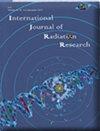纳米比亚埃隆戈地区乌萨科斯大理石的天然放射性水平和辐射危害评价
IF 0.4
4区 医学
Q4 RADIOLOGY, NUCLEAR MEDICINE & MEDICAL IMAGING
引用次数: 0
摘要
背景:纳米比亚埃隆戈地区的大部分地区显示出高本底辐射。本研究的目的和目的是确定Erongo地区Usakos大理石圆顶的天然放射性水平并评估其辐射危害。材料与方法:采用高纯锗(HPGe)探测器,测定了纳米比亚Erongo地区Usakos大理石圆顶20个不同地点的大理石样品中226 Ra、232 Th和40 K的活度浓度。结果:226 Ra、232 Th和40 K的平均活性浓度分别为0.37 ~ 339.60 Bq kg - 1、0.20 ~ 210.30 Bq kg - 1和2.96 ~ 928.70 Bq kg - 1。用226 Ra、232 Th和40 K的活度浓度估算镭当量活度(Ra eq)、吸收剂量率(Dr)、内外危害指数(H ex & H in)和活度利用指数(I γ)。计算的平均值为Ra eq (226.75 Bq kg - 1)、Dr (102.99 nGyh - 1)、hex(0.61)、hin(0.95)和I γ(1.59)。结论:从放射学的角度来看,(Dr)和(I γ)的结果高于世界推荐的平均水平,所进行的相关分析显示232 Th和226 Ra之间存在很强的正相关,这证实了这些放射性核素是Usakos大理石圆顶伽马辐射的主要来源。部分采样点的高活度浓度高于世界平均值,可能对建筑材料用大理石样品造成辐射危害。本文章由计算机程序翻译,如有差异,请以英文原文为准。
Natural radioactivity levels and evaluation of radiological hazards in Usakos marble, Erongo region, Namibia
Background : Most parts of the Erongo region of Namibia have shown high background radiation. The aim and objective of this study is to determine the natural radioactivity levels and evaluate the radiological hazards in Usakos marble dome in the Erongo region. Materials and Methods : A high purity germanium (HPGe) detector was used in this study to measure the activity concentrations 226 Ra, 232 Th, and 40 K in marble samples from 20 different points in Usakos marble dome in the Erongo region, Namibia. Result : The mean activity concentrations were found in the range of 0.37 to 339.60 Bq kg - 1 for 226 Ra, 0.20 to 210.30 Bq kg - 1 for 232 Th, and 2.96 to 928.70 Bq kg - 1 for 40 K, respectively. The activity concentrations of 226 Ra, 232 Th, and 40 K were used to estimate values of radium equivalent activity (Ra eq ), Absorbed dose rate (Dr), internal and external hazard indices (H ex & H in ) and the activity utilization index (I γ ). The calculated mean values were Ra eq (226.75 Bq kg - 1 ), (Dr) (102.99 nGyh - 1 ), H ex (0.61), H in (0.95) and I γ (1.59). Conclusion : From a radiological point, the results of (Dr) and (I γ ) were found above the world recommended average and the performed correlation analysis showed strong positive correlation amongst 232 Th and 226 Ra, which confirms these radionuclides as the main contributors to gamma radiation in the Usakos marble dome. The high activity concentrations at some sampling points higher than the world average value pose possible radiological hazards for the marble samples usage for building materials.
求助全文
通过发布文献求助,成功后即可免费获取论文全文。
去求助
来源期刊

International Journal of Radiation Research
RADIOLOGY, NUCLEAR MEDICINE & MEDICAL IMAGING-
CiteScore
1.10
自引率
33.30%
发文量
42
期刊介绍:
International Journal of Radiation Research (IJRR) publishes original scientific research and clinical investigations related to radiation oncology, radiation biology, and Medical and health physics. The clinical studies submitted for publication include experimental studies of combined modality treatment, especially chemoradiotherapy approaches, and relevant innovations in hyperthermia, brachytherapy, high LET irradiation, nuclear medicine, dosimetry, tumor imaging, radiation treatment planning, radiosensitizers, and radioprotectors. All manuscripts must pass stringent peer-review and only papers that are rated of high scientific quality are accepted.
 求助内容:
求助内容: 应助结果提醒方式:
应助结果提醒方式:


